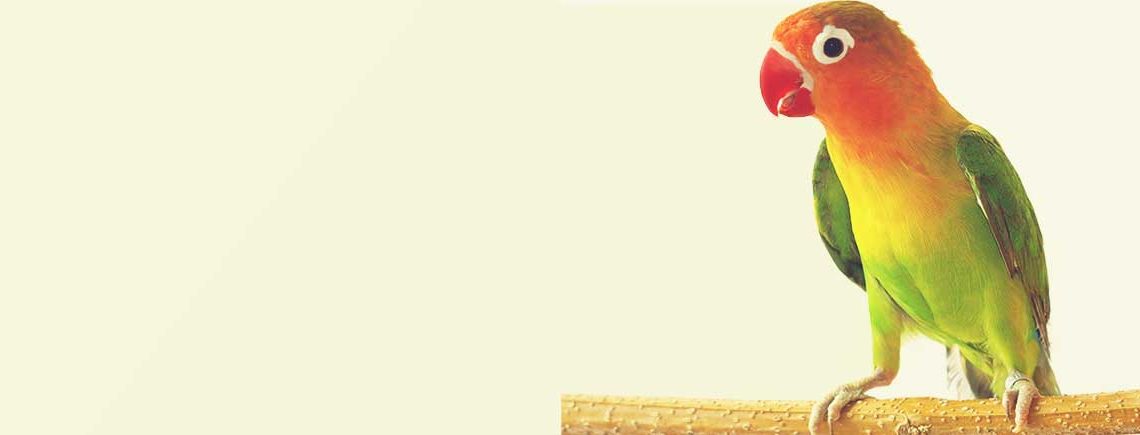Popular Pet Birds – Lovebirds
Choosing a Pet Bird: A little bit about Lovebirds
Birds can make wonderful pets, but there are many different types of birds, so how do you choose the one that is right for your family? Like any pet, birds will require lots of love and care to help keep them healthy and well, so in this blog we are taking a look at Lovebirds, and what you can expect if you were to have a one as a pet.
Lovebirds are curious, energetic, charming birds with a wonderful personality. It is recommended that you keep Lovebirds in pairs (male and female). The Lovebird’s wonderful personality shines through when you hear them sing.

Different Types of Lovebirds:
Peach-Faced Lovebirds
The Peach-Faced Lovebird has a green body; the head around the throat and breast are a bright peach pink with a peach coloured face. The Peach-Faced Lovebirds have black, blue and red flight feathers.
Masked Lovebirds
The Masked Lovebird has a dark head and the wings are dark green. The breast and around the neck are yellow and the flight feathers are black, with a red beak.
How Long Do Lovebirds Live?
The average lifespan for Lovebirds is 7-10 years.
Company for Lovebirds
Lovebirds should not be housed with different types of birds, therefore, it is best to keep the same breed of bird. They can be kept in pairs (male and female is better), however, their true personality shines true when they are singing.
Where Lovebirds Like to Live?
A metal cage is best suited to the needs of a lovebird, the minimum size for the cage is (18cm x 18cm x 24cm) with a bar space less than half an inch. In addition, perches should be provided in the cage allowing the Lovebirds to exercise and stretch their wings. For bedding, sand paper or wood shavings are recommended. Their food and water bowls should be made available if they are not provided with the cage. We find stainless steal bowls are best so the Lovebirds don’t chew them.
Bird Hide/Nest Box
Lovebirds like special resting places, such as nest boxes placed up high so all the birds are at the same level; and all of the same breed work well and it helps prevent fights.
Exercise & Play
Lovebirds awaken with the dawn; get a drink, eat, and then immediately begin to chirp. They will generally quieten down by mid-morning; and resume their chirping in the late afternoon. These birds are very active; they love flying and climbing about, gnawing on wooden or chew toys; and grooming themselves many times throughout the day. They love toys of all kinds such as seed bells, swings, ladders, mirrors, shiny objects, and wooden gnaws.
A Lovebird outside of it’s cage will not stay on it’s playpen, they like to explore; therefore be sure this room is safe with no open doors or windows; no toxic plants, no open water containers, and no hot stoves.
Diet & Nutrition
The diet of a Lovebird should consist of millet, oats, sunflower, corn, hempseed (bird mix) with the addition of fruits and vegetables. However, small quantities of parrot mix can also be given. A cuttlebone should be made available, this will help maintain the Lovebird’s beak and also provides a source of calcium. In addition, as a treat, a millet spray is best which is dried seed.
Lovebirds drink plenty of water so make sure there is fresh water available every day. Do NOT feed your Lovebirds avocado as it is toxic to these birds.
Health & Hygiene
The cage and perches should be cleaned on a regular basis (weekly), with new fresh bedding provided each time. The cage should be cleaned using a bird safe disinfectant, while perches, toys, and dishes should be washed using warm water.
Lovebirds love to take baths at least twice weekly. Make sure the bird bath is not full up to high as you do not want your bird drowning, or alternatively use a mist sprayer, misting the Lovebirds with water.
Take Me Home Checklist
Before you take your Lovebird home, you will need to make sure you have some things in order to help keep them healthy and happy. We’ve put together a simple ‘Take Me Home’ checklist for new Lovebird keepers. If you have any questions, or need any further advise, please drop in to your local Petmania and talk to our Petcare Advisors
- Metal cage (18cm x 18cm x 24cm)
- Food (cockatiel mix & parrot mix)
- Bedding (sand paper or beech chippings)
- Food and water bowls
- Toys (ladders, ropes, bells, chain links)
- Cuttlebone or mineral block
- Bird bath or mist sprayer
- Bird safe disinfectant
- Treats (millet spray)
- Lovebird book

